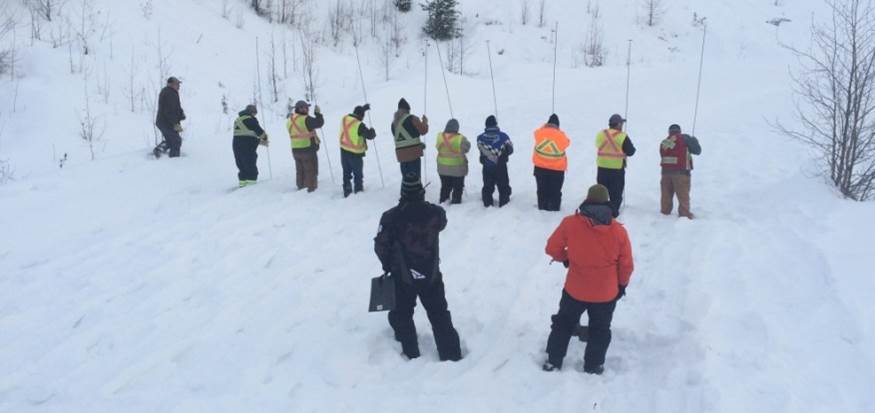
Ministry maintenance contractors spend a lot of time on the road in winter – but it’s not just about plowing and sanding. Should an unexpected avalanche cover an open highway, these workers are nearby and ready to help.
Contractor staff who supervise employees working in avalanche zones must complete the week-long Resource and Transportation Avalanche Management course provided by the Canadian Avalanche Association. This includes staff like the general manager, operations manager, superintendents and foremen who are responsible for highways and roads below some 1,388 avalanche paths in BC. Training requirements were increased in the 2018 maintenance contracts – previously training was one day. Avalanche training now covers climate/forecasting, snow profiles, avalanche risk assessments, response plans, and search and rescue.
It also includes:
- the contractor’s typical role of closing a route for avalanche control work
- “sweeping” to ensure no one is in the area
- and after the avalanche control is complete, clearing the route of any debris and re-opening the highway.
As the avalanche season rolls out, the maintenance contractors’ search and rescue knowledge is put to the test. For example, the ministry’s Northwest Avalanche Program employees led a practice in the Stikine area. Lakes District Maintenance crews from Telegraph Creek, Cassiar and Dease Lake reviewed the ministry avalanche search and rescue plan, and participated in a mock rescue.
The scenario revolved around a large avalanche reported by the public to our ministry’s Regional Transportation Management Centre, affecting Highway 37, about 139 kilometres north of Dease Lake. The avalanche was found to be 75 metres wide and three metres deep – deep enough to bury a vehicle and launch our avalanche search and rescue plan.
Amid -18 C temperatures, everyone focussed on the practice and demonstrated a solid understanding of how the avalanche rescue would unfold. They also practiced avalanche transceiver use and probing and shovelling skills used to locate buried avalanche victims.
This training is critical to keeping the public safe in our mountainous province, and ensuring our maintenance personnel stay safe while doing their essential work. It’s all in a day’s (avalanche) work!
If you thought this was interesting, check out our video and blog about fencing avalanche-prone areas.
More about how maintenance contractors work with us on avalanche control:
How We Catch Avalanche Debris to Reduce Highway Closure Times
Join the discussion